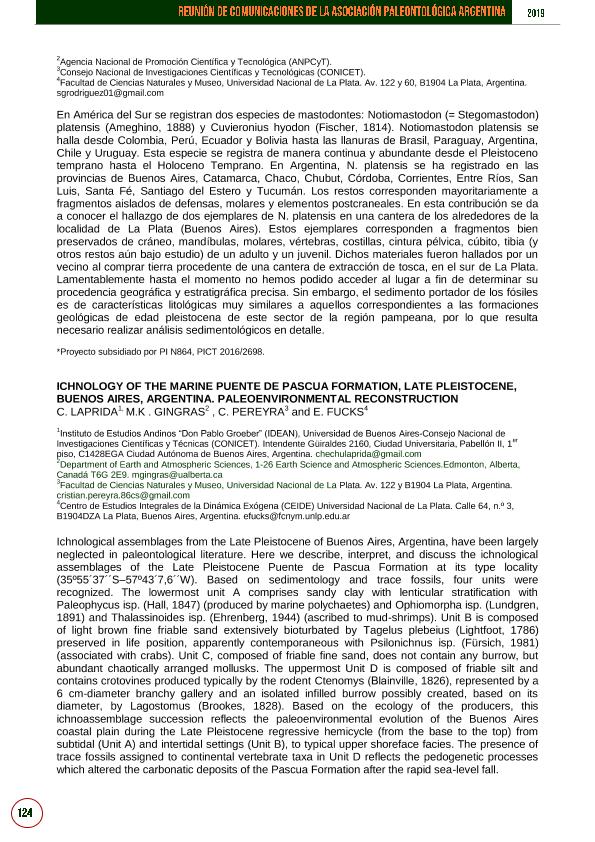Evento
Ichnology of the marine Puente de Pascua Formation, Late Pleistocene, Buenos Aires, Argentina
Tipo del evento:
Reunión
Nombre del evento:
Reunión de Comunicaciones de la Asociación Paleontológica Argentina
Fecha del evento:
27/11/2019
Institución Organizadora:
Asociación Paleontológica Argentina;
Título del Libro:
Libro de Resúmenes: Reunión de Comunicaciones de la Asociación Paleontológica Argentina
Editorial:
Asociación Paleontológica Argentina
Idioma:
Inglés
Clasificación temática:
Resumen
Ichnological assemblages from the Late Pleistocene of Buenos Aires, Argentina, have been largelyneglected in paleontological literature. Here we describe, interpret, and discuss the ichnologicalassemblages of the Late Pleistocene Puente de Pascua Formation at its type locality(35o55 ́37 ́ ́S?57o43 ́7,6 ́ ́W). Based on sedimentology and trace fossils, four units wererecognized. The lowermost unit A comprises sandy clay with lenticular stratification withPaleophycus isp. (Hall, 1847) (produced by marine polychaetes) and Ophiomorpha isp. (Lundgren,1891) and Thalassinoides isp. (Ehrenberg, 1944) (ascribed to mud-shrimps). Unit B is composedof light brown fine friable sand extensively bioturbated by Tagelus plebeius (Lightfoot, 1786)preserved in life position, apparently contemporaneous with Psilonichnus isp. (Fürsich, 1981)(associated with crabs). Unit C, composed of friable fine sand, does not contain any burrow, butabundant chaotically arranged mollusks. The uppermost Unit D is composed of friable silt andcontains crotovines produced typically by the rodent Ctenomys (Blainville, 1826), represented by a6 cm-diameter branchy gallery and an isolated infilled burrow possibly created, based on itsdiameter, by Lagostomus (Brookes, 1828). Based on the ecology of the producers, thisichnoassemblage succession reflects the paleoenvironmental evolution of the Buenos Airescoastal plain during the Late Pleistocene regressive hemicycle (from the base to the top) fromsubtidal (Unit A) and intertidal settings (Unit B), to typical upper shoreface facies. The presence oftrace fossils assigned to continental vertebrate taxa in Unit D reflects the pedogenetic processeswhich altered the carbonatic deposits of the Pascua Formation after the rapid sea-level fall.
Palabras clave:
icnología
,
Plesitoceno Superior
,
Formación Pascua
Archivos asociados
Licencia
Identificadores
Colecciones
Eventos(IDEAN)
Eventos de INSTITUTO DE ESTUDIOS ANDINOS "DON PABLO GROEBER"
Eventos de INSTITUTO DE ESTUDIOS ANDINOS "DON PABLO GROEBER"
Citación
Ichnology of the marine Puente de Pascua Formation, Late Pleistocene, Buenos Aires, Argentina; Reunión de Comunicaciones de la Asociación Paleontológica Argentina; La Plata; Argentina; 2019; 1-1
Compartir




